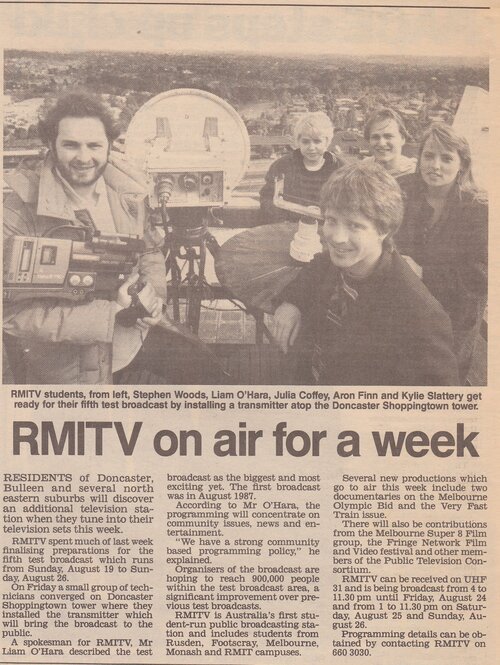Our Story
A television transmitter, built by engineering student Martin Schneeberger in 1985 for his final year project, became the catalyst for RMITV. The following year he decided to create a TV station for his transmitter, rather than leave it redundant. Shows were produced by journalism and media students and transmitted from within the university’s city campus, and only to the campus.
The temptation to develop a real community television station, in the same way that radio had been doing since the first community radio station in Australia was licensed in 1972, proved strong. An application was made for a broadcasting licence but, meeting with resistance from the federal government Schneeberger teamed up with Steve Middleton from Footscray University and John Saradon from Saint Kilda Access (SKA). They told Channel 10 they were going to establish a pirate station, and were subsequently interviewed by Mal Walden for the news. What the Channel 10 news crew found was three students with a pirate flag wearing balaclavas and insisting no one could stop them establishing a pirate station.
The interview made for a good news story and the following year, in 1987, the government provided three temporary licences to community stations providing for two hours of broadcast time every two weeks for two years. The fledgling RMITV had no content to air so Schneeberger spoke to the journalism students and two news programs were produced – Red Eye News and Newsline, aired from the top of the RMIT city campus to the nearby suburbs of North Melbourne, Brunswick, Carlton and Fitzroy.
The transmitter was moved several times over the next few years, eventually ending up transmitting from the Doncaster Shoppingtown tower in 1993. Later in 1987 two other shows were produced: The World Is Not Round (the name was later changed to Under Melbourne Tonight) and Seizure. RMITV hired equipment from the media department. Other community television organisations included SKA who broadcast from the Prince of Wales hotel, followed shortly by RAT – Richmond Access Television.
RMITV was the first community television station in Australia to receive a test transmission permit from the government. The growth of community television stations in Melbourne [SKA in 1988, RAT soon after, NAT in 1990 and Bent TV after 1993] gave rise to a plan for a conglomeration able to provide year round content. The conditions of a community television licence differ from commercial licenses in that programming is only for community, educational and non-profit purposes and is to be produced by private citizens under an open narrowcast class licence.
The organisations joined in 1990 to form the Melbourne Community Television Consortium [MCTC] and lobbied for a trial community broadcasting license, which was issued in 1994. Melbourne Community Television Channel 31, shortened to MCT-31, began evening broadcasts on 6 October that year. In 2001 they began daytime broadcasting as well, and in 2004 24-hour broadcasting began and a permanent community broadcasting licence was issued.
A short news piece showing the beginning of RMITV, filmed in 1987.
Designed by RMITV member Nic Mason in the early 2000s, the "R" and "M" in RMITV's logo are based on the series of classification marks from the OFLC used to designate "Restricted" and "Mature" broadcast content and the "I" and "TV" are based on the 'General' (G) and 'Parental Guidance' (PG) classification marks but making use of different letters and antennas on the TV to signify television
The advent of MCT-31 was a significant moment in Australian television history. It provided an alternative station to Melbourne audiences with content that was Australian television history. It provided an alternative station to Melbourne audiences with content that was different from the commercial or government channels and it provided an opportunity for on-screen and production experience to anyone who wanted it. It was also significant for RMITV as it meant the end of RMITV as a television station transmitting programmes, and the beginning of its role as a production house. Since being one of five founding members of MCTC in 1990, and one of forty members of the Consortium today, RMITV has been the most prolific community television production house in Victoria. As with all community stations, the policy was always for public access programming.
RMITV was a student run group and remains so to this day, but its membership policy embraces anyone who would like to give TV production a go and it has become a well-established training ground for students and non-students alike.


























Related articles:
Cyberthon: Capturing the rave scene in 90’s Melbourne - (22/12/2020)
Everything about Rove McManus - Yahoo Lifestyle - (09/06/2020)
Cupid’s Arrow Strikes - a look into new webseries ‘Campus Cupid’ - The Swanston Gazette - (01/05/2020)
Dancing With our Stars | Meet your hosts Julia Zass and Bryce Ives - The Courier - (08/05/2019)
Students gather for Calder Park showdown - speedcafe.com - (07/12/2017)
Channel 31 is Shutting Down - Broadsheet Melbourne - (30/11/2016)
Videocraft Designs, Supplies, Builds and Installs New Television Studio for RMIT - videocraft.com.au (16/11/2015)
Birthplace of Melbourne community TV to be demolished - ABC Radio Melbourne - (18/06/2015)
RMITV Returns to Live Television - medianet.com.au - (28/04/2015)
Student media needs student fees to survive - ABC News - (26/09/2013)
In Pit Lane turns 100 - motorsport.com - (25/02/2001)






